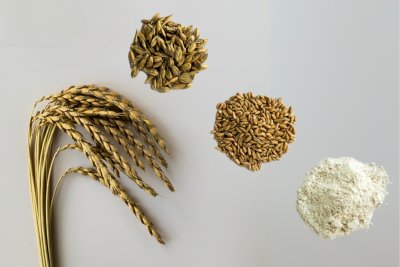Sustain / Real Bread Campaign / Articles
Can flour power change the world?
Campaign ambassador Camila MarciÌas is on a heritage and whole grain journey of discovery.

I’m the head pastry chef at e5 Bakehouse in east London. I often find myself thinking about food (maybe too much), which is why I started considering the role of flour. As bakers and cooks, we use a significant amount of it as an ingredient, but many of us don’t stop to think about its origin, or much else other than its technical baking qualities.
When I studied in France, the only considerations were its type: T45 or T65, for example. These numbers relate to their mineral content (the greater the amount of bran, the more minerals the flour contains and the higher the number) which helps to determine its suitability for bread or pastries. That was typically as far as the discussion went.
While I don't consider myself an expert on grains, I do have some knowledge about growing and using various types and varieties. Watching seeds transform into plants, which later bear new grains, then milling and baking with them, has given me a profound appreciation for grains and a deep sense of fulfilment.
Sowing the seeds of discovery
For many years, I didn’t give much thought to flour beyond looking at the gluten content. This was until I met Mahala Le May, who was the first friend I made in Cambridge. She introduced me to a world where flour is of the essence. That summer, I attended a field-to-loaf workshop at Waterland Community Supported Agriculture (CSA) organic farm, where Heron Holmes and Nick Fradgley had cultivated a wide variety of population grains. We harvested rye with a sickle, separated the grain using a bicycle-powered thresher and winnower, turned it into flour using a Mockmill, then baked our loaves in an earth oven they had built earlier that summer.
By that autumn, I was planting seeds in my tiny garden with Mahala. We sowed Maris Widgeon, a long-straw, modern variety of wheat that was released by the Cambridge-based Plant Breeding Institute in 1964. I joined the East Anglia Grain Alliance, visited Wakelyns farm in Suffolk, and met like-minded bakers, millers and farmers interested in changing our food system through grains. But why? How? And why does it matter?
Value removed
What we put on our table has very important repercussions not just for our health but for the planet’s health. Agricultural biodiversity on our plates is currently less than ever before. While there are more than 30,000 species of edible plants, we only eat a fraction of them. At a global level, approximately 75% of the calories we consume come from just 12 types of plant and five types of animal. In 2019, the UN published a global biodiversity report. This revealed that nearly one million plants and animals are in danger of extinction, or are already considered extinct. These losses are a threat to the preservation of our ecosystems and the survival of our cultural traditions and our communities.
Growing heritage varieties offer a wider range of flavours, help regenerate our soil, support local communities and farmers, and promote a circular economy, all while contributing to food sovereignty. This is all enhanced when the whole grain is turned into flour, rather than removing a large percentage of it - see wholemeal: better bred bread. By contrast, white flour lacks flavour, character, fibre and natural micronutritional content. It is primarily produced through agrochemical-dependent, monocultural farming practices that deplete the soil, which has contributed to environmental damage by companies that have exploited the land for centuries. It is usually made from modern varieties of wheat, stripped of their germ and bran, then sold in a commodified market. Commodified food systems take value away from the farmer and other producers, away from people like you and me.
What stories should food tell?
Food is not only about knowledge of cooking and techniques. I believe that food should tell a story. The story I want to tell is about resilience, of the soil beneath our feet, about humans taking care of those fields, of sustainability and creativity. While it is easier to go with the state of affairs and keep relying on white flour, using different grains is jumping to the unknown and unexpected, pushing you to develop a new set of skills. I want to use these new skills that I am developing to improve our food system, to question things and to make a positive impact in my community and beyond.
Originally published in True Loaf magazine issue 62, April 2025. This article is adapted from one Camila published on her Latina Cooking Substack.
Bake Your Lawn
Order your copy of the Real Bread Campaign’s grow-a-loaf guidebook today! The book includes year-round Lessons in Loaf to share with children in the classroom, at home or in community settings.
See also
- Let's make Britain great again!
- Wholemeal bread
- Grassroots grain Britain
- Rebel alliance
- Cultivating a new local grain economy
- A gathering of grainiacs
- Why queue for YQ?
- Landrace for life
- An adaptive approach to wheat breeding, growing, processing and baking
- Capital grains
- Around the world for a local loaf
- A new Welsh grain economy
- Mountin' a comeback
- Local grain guide
- Weaving new bread webs
Published Monday 7 April 2025
Real Bread Campaign: Finding and sharing ways to make bread better for us, our communities and planet.

